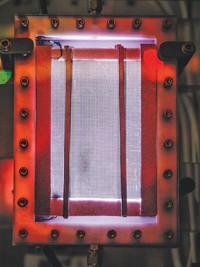Advertisement
Grab your lab coat. Let's get started
Welcome!
Welcome!
Create an account below to get 6 C&EN articles per month, receive newsletters and more - all free.
It seems this is your first time logging in online. Please enter the following information to continue.
As an ACS member you automatically get access to this site. All we need is few more details to create your reading experience.
Not you? Sign in with a different account.
Not you? Sign in with a different account.
ERROR 1
ERROR 1
ERROR 2
ERROR 2
ERROR 2
ERROR 2
ERROR 2
Password and Confirm password must match.
If you have an ACS member number, please enter it here so we can link this account to your membership. (optional)
ERROR 2
ACS values your privacy. By submitting your information, you are gaining access to C&EN and subscribing to our weekly newsletter. We use the information you provide to make your reading experience better, and we will never sell your data to third party members.
Business
New paradigm for ammonia pursued
Japanese partnership to commercialize low-pressure approach to making basic chemical
by Michael McCoy
May 8, 2017
| A version of this story appeared in
Volume 95, Issue 19

The Japanese amino acid maker Ajinomoto is teaming up with Tokyo Institute of Technology professor Hideo Hosono and other partners to commercialize what they say will be the world’s first small-scale, on-site ammonia synthesis system.
Today, essentially all ammonia in commerce is made by the Haber-Bosch process, a century-old catalytic technology that couples hydrogen with nitrogen at high temperature and pressure.
The drawback of the Haber-Bosch process is that it is cost-effective only in large, expensive, generally centralized plants. Hosono’s research group has come up with a new catalyst that, according to the partners, enables efficient ammonia synthesis in small facilities under low-temperature and low-pressure conditions.
The partners aren’t disclosing the specific catalyst. However, a recent research paper from Hosono and colleagues describes catalyzing ammonia production with ruthenium nanoparticles deposited on a calcium aluminate electride.
The Japanese partners have formed a new company, Tsubame BHB, to commercialize the technology. Ajinomoto says it aims to install an ammonia facility by 2021 at one of its amino acid plants, which use fermentation to convert ammonia into products such as glutamic acid.
Researchers have long pursued low-cost, environmentally friendly ammonia production. Recently, two teams of academic chemists presented bioelectrochemical routes to ammonia at the ACS annual meeting in San Francisco. Electrochemical and other processes for ammonia production won funding last December from the Department of Energy’s Advanced Research Projects Agency-Energy arm.
The Haber-Bosch process is quite efficient and to date has been hard to compete against, notes Trevor Brown, a consultant who runs the website Ammonia Industry. “Proven technologies can be funded; unproven technologies have a far harder time attracting funding,” he says.
Nonetheless, several small-scale ammonia projects are advancing, Brown says, and may even open ahead of the Japanese effort. He points to a Siemens project near Oxford, England, and a demonstration plant planned by the Swedish firm Vattenfall. Both anticipate producing ammonia with hydrogen generated electrochemically from solar or wind power. The ammonia will then be burned as fuel at times when renewable energy comes up short.



Join the conversation
Contact the reporter
Submit a Letter to the Editor for publication
Engage with us on Twitter